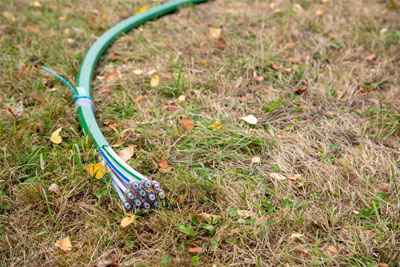How Do I Know If I Have Fiber Internet in My Home?

Not sure whether your home is connected to fiber or you’re hooked up to some other internet?

Not sure whether your home is connected to fiber or you’re hooked up to some other internet?
For most of us, fast internet is such an essential part of life that we assume it’s always available! Streaming, gaming, working from home – it all takes speedy internet from a local provider. We can get so used to it, in fact, that we forget what kind of internet we have (and whether it’s worthwhile to upgrade).
Fiber internet is becoming more popular every day, and many Americans need to know how to tell if they already have fiber internet or if they need to make a change. But how can you know whether your internet is from fast fiber cables, satellite signals, or something else entirely? That’s what we’ll break down below.
If you’re unsure about the type of internet connection in your home, don’t worry. You’re not alone! Many people are unaware of whether they’re using fiber, cable, DSL, or another type of service. The good news is that there are a few clear indicators you can look for to find out if you’re enjoying the lightning-fast benefits of fiber, and you don’t have to be a tech expert.
The simplest place to start is with your monthly internet bill. Most internet service providers (ISPs) clearly label the type of plan you’re paying for.
Look for words like “fiber,” “fiber-optic,” or model names that hint at it, like “Fios,” “FiberMax,” or “GigaFiber.” If it only says DSL, cable, or “broadband,” you’re not on a fiber plan.
Some ISPs even include connection type and speed tier in your online account dashboard. If you ask yourself how to know if you have fiber internet, logging into your ISP's portal can be a quick and reliable way to confirm.
When in doubt, just ask! Your ISP’s customer support team can quickly tell you what kind of infrastructure is connected to your home. It might seem like a hassle, but one quick phone call or live chat session can clear up any confusion.
Be sure to ask not only whether your house currently has fiber but also whether fiber is available in your area – you might be eligible for an upgrade if you don’t currently have fiber. Knowing your options can help you avoid overpaying for slower speeds.
If your home has an Optical Network Terminal (ONT), it’s a dead giveaway that you have access to fiber internet. An ONT is a small box installed by your provider that converts fiber optic signals (pulses of light) into a usable internet connection for your router. Glo Fiber installs ONTs inside your home, often in a garage, basement, utility closet, or near where the fiber cables enter the house.
This is different from a cable modem. A cable modem will likely be connected to the wall via a coax cable, whereas an ONT will be connected by a much thinner fiber cable, and you likely will not be able to see it.
Unlike a traditional cable or DSL modem, the ONT is specifically designed for fiber. If you see one labeled with “fiber” or “optical,” that’s your confirmation. Don’t see anything like that? You might still have fiber since your ONT could be in a spot you can’t see, but this clue can help you narrow things down. No other internet type needs an ONT.
Want a quick snapshot of your connection’s performance? Run an online speed test using tools like Speedtest.net, Fast.com, or your ISP’s own test (sometimes available from the same portal mentioned earlier). Fiber internet typically delivers symmetrical speeds, meaning your upload and download speeds are identical, or nearly so.
If your download speed is 200 Mbps and your upload speed is also hovering around that number, you’re likely on a fiber connection. If your upload speed is significantly lower (say, 10 or 20 Mbps), you’re probably using cable or DSL.
Fiber optic internet is fast, blazingly fast. If your home internet regularly clocks in at 500 Mbps, 1 Gbps, or even faster on the speed test, there's a strong chance you're on a cable or fiber plan. While some cable providers are starting to offer gigabit speeds, fiber still delivers the most consistent performance, especially during peak usage hours.
If you’re streaming on multiple devices, joining Zoom calls without freezing, and downloading files in seconds, it could be thanks to fiber. Of course, high speeds alone aren’t definitive proof since other internet types can also be fast, but they’re a solid clue.
If you’ve gone through these steps and determined that you don’t have fiber internet, don’t worry – there are still ways to improve your experience.
First, check with your provider to see if fiber is available in your area but hasn’t yet been connected to your address. Some providers offer free installations or low-cost upgrades when fiber becomes available.
If your current provider doesn’t offer fiber, look into competitors. Many regional and national ISPs are expanding their fiber networks into suburban and rural areas. Signing up for notifications or pre-registering can help bring service to your neighborhood sooner.
If you're tired of slow downloads, buffering video, and laggy Zoom calls, now’s the time to switch. Glo offers ultra-fast, reliable fiber internet with symmetrical speeds, low latency, and no data caps: perfect for modern households with high-demand internet usage.
Whether you're working from home, managing a smart home setup, or just want to stream without interruption, Glo delivers the seamless connectivity you need. And best of all, our friendly customer support team will help you determine if your home is fiber ready!
Don’t settle for less. Discover the difference fiber can make with Glo.